2023 Lexus RX First Drive Review: Bold colors, three hybrids, irksome tech

SANTA MARIA, Calif. – Every car has its color. It’s usually the one prominently photographed in press or marketing photos; the one its designers thought made the biggest impact. They’re often bold hues, though rarely popular. The original Lexus RX will forever be remembered painted Desert Bronze. It was as bold and distinctive as the vehicle itself – remember, the RX was the first real luxury crossover, arriving before the BMW X5 and at the same time Acura was trying to pawn off Isuzu Troopers. The RX would go on to be achingly bland, but in the beginning, it was radically new and different. Desert Bronze drove home that point.
As if to make a similar statement, the fifth-generation, 2023 Lexus RX arrives resplendent in Copper Crest. Despite the name, it’s more of a rose gold in person, and nothing else on the road is painted anything quite like it from the factory. It’s very of-the-moment, and in 25 years, we’ll all remember this RX in this color. Of course, the real question is whether the car itself will be worth remembering.
It’s at least a better-looking vehicle than the one it replaces, applying updated Lexus styling cues more cohesively to a body that looks like it was meant for them from the beginning. The silhouette is even less SUV-like now. Although the various models’ ground clearances are all over 8 inches and the overall height only 0.4 lower than before, the new RX sure looks lower than the old one in person, and just low in general for an SUV. There’s a bit of a giant hatchback thing going on, which isn’t necessarily a bad thing.
Key interior dimensions are virtually unchanged, if actually slightly below the previous generation. Clearly the sizable number of loyal RX customers didn’t have a beef with available space. For what it’s worth, a pair of rear passengers reported that the back seat was very comfortable with plenty of space despite a tall driver up front. Cargo capacity measures 29.6 cubic-feet with the back seat raised, which would be comparable to a Toyota Venza.
Interior quality doesn’t seem to be quite to the level of its predecessor, and the addition of a colossal screen rarely does aesthetic favors to a dashboard design. The RX is no exception, and while the new touchscreens available in 9.8- and 14-inch sizes provide improved functionality over the old Remote Touch touchpad-and-display system, that was a bar that could be cleared with a short hop. The new system still frustrates with a lack of physical shortcut buttons, excessive menu screen back-and-forths, and just too much placed within its purview. Even the driving modes are locked away within a touchscreen menu rather than the lovely rotary knobs found in previous-generation Lexus models.
The latest array of driver assistance tech is similarly updated yet ultimately frustrating. The latest Lexus Safety System+ 3.0 suite features updated and additional features, including a forward collision warning system that detects more incoming obstacles from more directions; steering assistance paired with the lane-departure warning system; and the optional Traffic Jam Assist that allows for low-speed hands-free driving in gridlock. Unfortunately, the driver inattention warning system in multiple test vehicles frequently boisterously alerted multiple drivers to pay attention to the road even though their eyes had indeed never wavered from it. That would drive you bonkers. The lane tracing assist system, which was supposedly upgraded, did a pretty inconsistent job of keeping the RX centered in its lane while using adaptive cruise control. In one modest right-hand highway sweeper, the car just ignored the lines completely and decided it should go straight into the left lane. System off.
One new “Assist” element was more impressive, the Pro-active Drive Assist that incorporates road data from the navigation system and visual data from onboard cameras to slow the vehicle when entering a corner or going downhill. We didn’t notice the cornering bit, but there was noticeable regenerative braking applied in both the RX 350h and RX 500h when descending a grade. It’s indicative of a low regen setting in an EV. In the past, you’d have to select “B” with a Toyota hybrid’s transmission selector to achieve what is effectively akin to engine braking. Now, the car does it automatically. There are differing levels of assist available, including the option to simply turn it off.
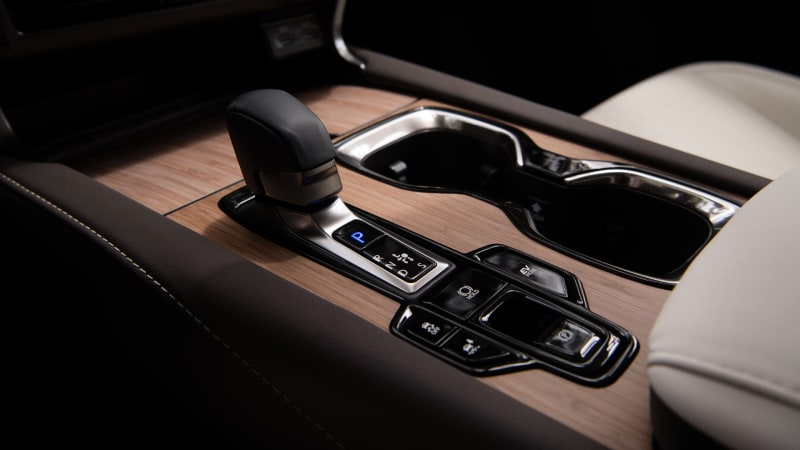
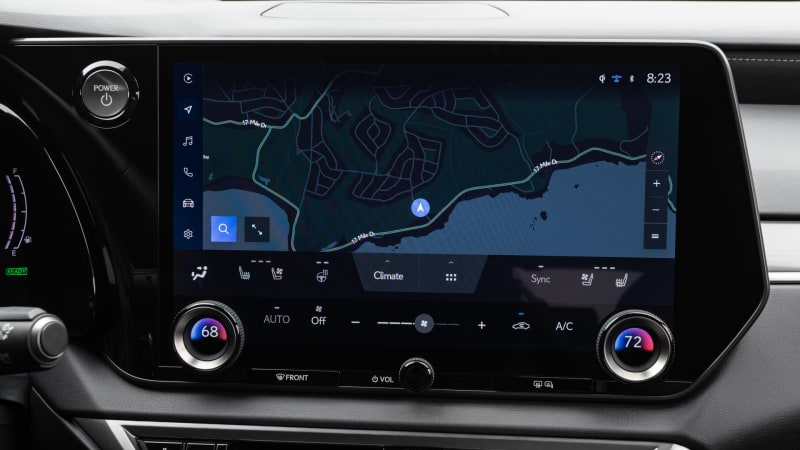
The 2023 RX is brand-new from the ground-up, adapting the same TNGA-K platform variant as every front-drive Toyota and Lexus north of a Corolla. Lexus likes to leave off the “TN” when describing it because the T stands for Toyota, but rest assured, the RX shares its mechanical DNA with a RAV4 or Sienna.
BMW shoppers may snicker at that, but ultimately, the RX enjoys the same dynamic and packaging improvements as every TNGA vehicle that’s debuted – and at this point, there have been many. It responds more sharply to inputs, shows greater composure on undulating pavement and provides a driving position that’s more sitting-in than sitting-upon. Lexus happily provided a previous-generation RX to drive back-to-back, and the new version had noticeably tauter steering, with less play on center, regardless of driving mode. Everything feels just a bit sharper.
The RX 350h (pictured below) also now boasts a quieter and more refined iteration of Toyota’s familiar hybrid powertrain setup. As a refresher, that includes a naturally aspirated inline-four, two motors up front that help power the wheels and vehicle accessories, and a planetary gearset that combines with those motors to create what Toyota calls an e-CVT (since the end result is similar to that of a traditional belt-and-pulley CVT). A third motor at the rear axle creates at-the-road all-wheel drive by kicking in when front-wheel slippage is detected.
The upside is exceptional fuel economy for a midsize SUV: 36 mpg combined, or 12 mpg better than the RX 350’s new 2.4-liter 275-horsepower turbocharged inline-four (more on that later). The downside is pokey acceleration. The 0-60 time is officially 7.4 seconds, and it feels even slower when motoring onto the highway due to the gravelly naturally aspirated engine and droning e-CVT. Basically, it’s what you’d expect from a hybrid.
For 2023, though, the RX is doing its best to change those expectations with two additional hybrid choices. The new RX 450h+ adopts the same plug-in hybrid powertrain format as the new NX 450h+ (details were scarce so we only assume the systems themselves are identical). It effectively takes the regular hybrid powertrain and enhances it with a substantially larger, 18.1-kilowatt-hour battery that will allow some amount of electric range that will be announced later. The NX 450h+ can go 37 miles with the same battery, so something in that ballpark seems likely. Although it will be available later than the other RX models, we got a chance to take a short 15-minute drive where we discovered it pretty much drives like the NX 450h+ and closely related RAV4 Prime. Accelerating in EV-only mode is smooth and rewarding in its ability to drive without burning fossil fuels, but is ultimately gutless as there’s just not enough available on the upper end of the power band. Driving in hybrid mode keeps you running on electricity as much as possible, but if you punch it, the gas engine will come on for much zestier acceleration than the RX 350h can muster thanks to the greater amount of electrons available. That zest also cuts down on the droning even if it still has the e-CVT.
Then there’s the new RX 500h, which has an entirely new hybrid powertrain for Lexus (it’ll be eventually shared with the Toyota Crown). It features the same turbocharged engine as the gas-only RX 350, which is significant in itself for a Lexus hybrid application. Instead of the e-CVT, the RX 500h has a single electric motor sandwiched between the engine and a conventional six-speed automatic transmission. Within that sandwich is a clutch pack that allows the engine to either power the wheels or act as a generator to feed the battery (the Toyota Tundra has a similar hybrid setup, but has a torque converter in place of the clutch pack). The end result is a far more normal driving experience with gear changes, no droning and plenty of smooth, low-end torque courtesy the turbocharger and electric motor. Drivability is markedly better, but Lexus says this new hybrid concept was created for the purposes of performance applications (much like the Tundra).
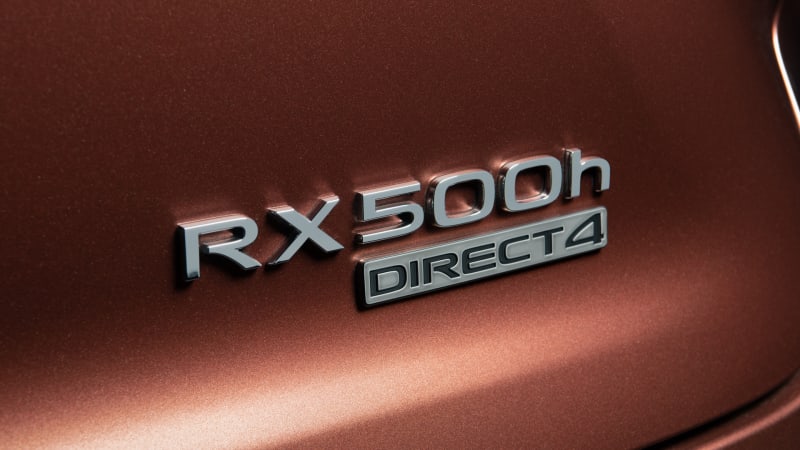
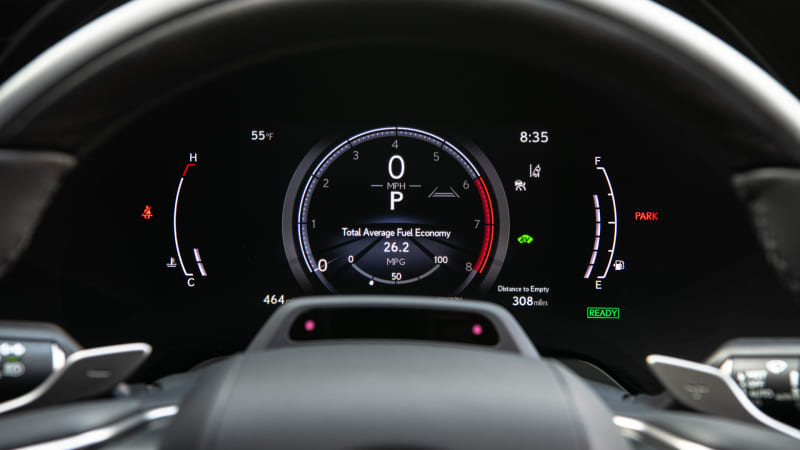
The electrified all-wheel-drive system is just as new. Although the RX 500h also relies on a separate electric motor to solely power the rear axle without a mechanical connection to the powertrain up front, it isn’t just a reactive system that only engages when the front wheels need a hand. Like many mechanical all-wheel-drive systems, the “Direct4” AWD system proactively sends power to the 80-kilowatt “eAxle” based on input from wheel speed, acceleration and steering angle sensors, plus the current drive mode. The front:rear power split can vary as much as 100:0 to 20:80. The goal is effectively to provide a front-biased system when in cruising situations, a rear-biased system when carving corners and something close to 50:50 when gunning it from a stop.
It’s a neat system, but we frankly look forward to trying it in something other than the RX. Total system output of the RX 500h stands at a healthy 366 horsepower and 406 pound-feet of torque, but the 0-60 time is 5.9 seconds. That’s a bit underwhelming for something officially dubbed the RX 500h F Sport Performance, which is an impression shared after actually driving the thing. It definitely moves, but for a range-topping luxury model, it’s hard not to be underwhelmed with the shove you get.
At least it’s quicker than the surprisingly sluggish RX 350, which hits 60 mph in either 7.6 seconds with FWD or 7.2 with AWD. It produces a commendable 275 hp and 317 lb-ft of torque from its 2.4-liter turbocharged inline-four, and is actually about a half-second quicker than the old 3.5-liter V6 (295 hp and 267 lb-ft), but those are still compact non-luxury SUV acceleration times. Shouldn’t a luxury vehicle go beyond “sufficient”? All the more reason to go with one of the hybrids, then. The RX 350 may get 2 mpg combined better than the old V6 (25 mpg combined with FWD and 24 mpg combined with AWD), but that’s obviously far worse than the RX 350h’s 36 combined and the RX 500h’s 27 combined.
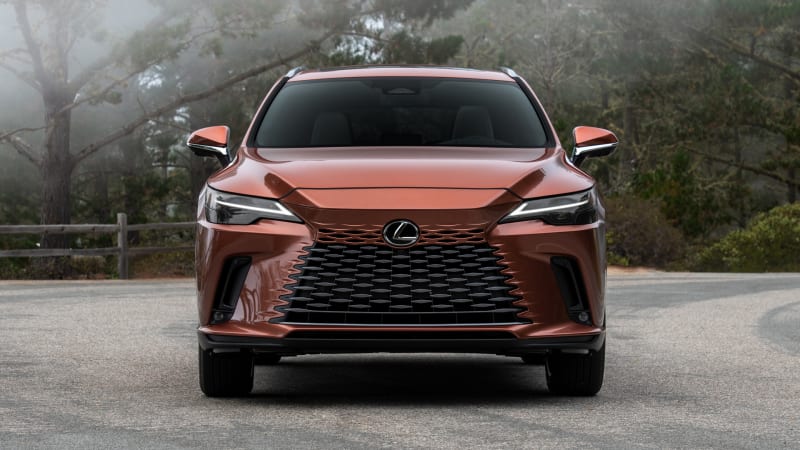
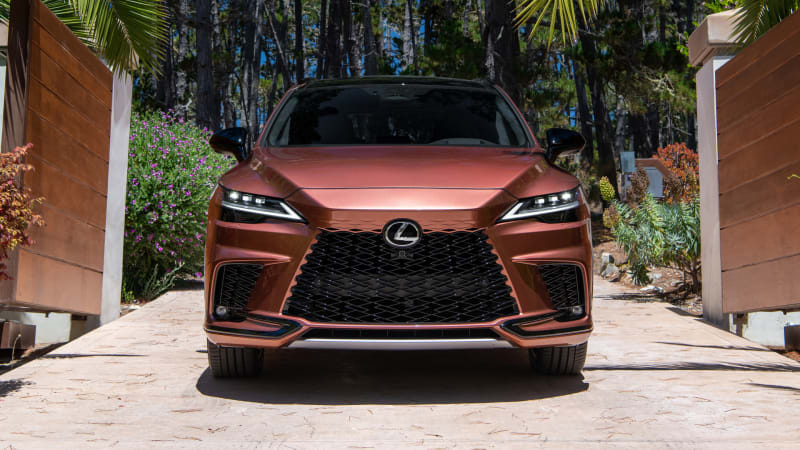
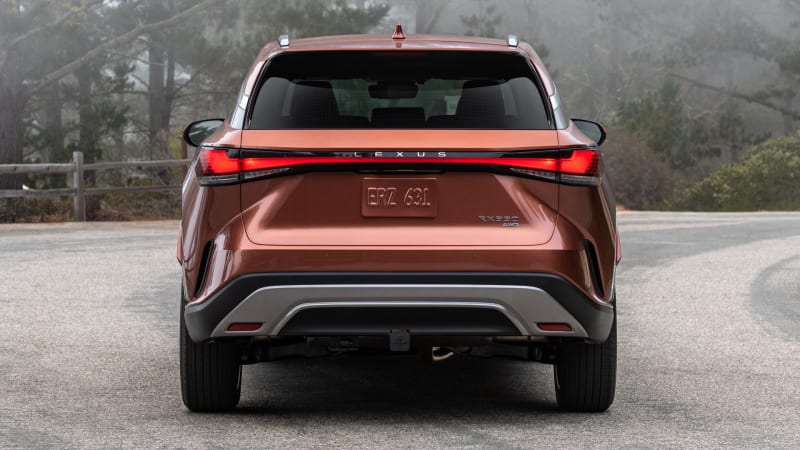
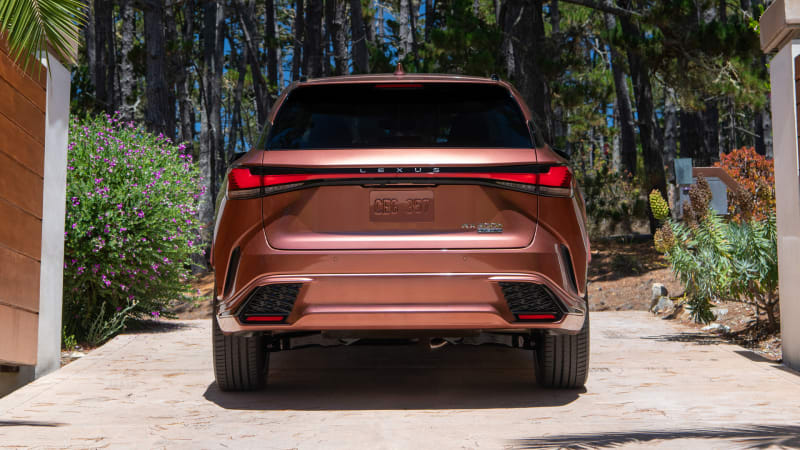
The RX 500h is exclusively offered in F Sport Performance guise, while the RX 350 is available in an F Sport Handling variation. Both get common styling differences, which can be seen above with the regular (left) and F Sport (right). The grille is the most obvious change, though there are subtle trim differences that’ll tell you whether you’re looking at a 500h or 350 (the hybrid’s extra black trim and bulging lower rear bumper are the best giveaways). Both are also available with adaptive suspension, while the RX 500h alone can be optioned with a rear-wheel steering system. None of the roads we drove during our test were close to being twisty enough to notice the 4 degrees of possible rear wheel articulation, nor is the RX large enough to make the parking advantages obvious. Every 2023 RX gets a revised suspension, including MacPherson struts up front and a new five-link rear that takes up less space than before.
When the 2023 Lexus RX goes on sale at the end of this year at prices to be announced later, repeat buyers should find that it builds smartly on its predecessor with key improvements and additions. Indeed, repeat buyers are a big deal as Lexus anticipates 33% of RX buyers will be previous owners with an additional 9% coming from another Lexus. Now, for those who haven’t taken an RX home at some point since that Desert Bronze original’s debut, there’s a decent chance you’ll be underwhelmed by its performance and irritated by its technology. Its multiple hybrids give it something no other midsize luxury SUV has, however, and given gas prices and the climate crisis, that advantage is huge.



